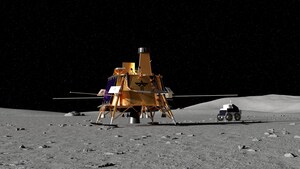WASHINGTON, April 20, 2015 /PRNewswire-USNewswire/ -- NASA researchers have wrapped up a series of flight experiments with Boeing's ecoDemonstrator 757 airplane, testing technologies designed to reduce fuel consumption and emissions.
The first of these tests, the Active Flow Control Enhanced Vertical Tail Flight Experiment, assessed the effect of tiny devices called sweeping jet actuators. Thirty one of these devices were installed on the aircraft's vertical tail, which provides stability and directional control during takeoff and landing, and tested to determine what – if any – effect they had on the aerodynamics of the tail and rudder surfaces.
"If we can control the flow of air over the vertical tail on demand, we believe we can provide enough side force during take-off and landing that aircraft manufacturers can safely make the tail smaller," said Mike Alexander, lead systems engineer for the flight tests at NASA's Langley Research Center in Hampton, Virginia. "The ability to reduce the size of the vertical tail would reduce weight and drag and decrease fuel consumption and emissions."
To validate this theory, the ecoDemonstrator made six roundtrip flights April 9-15 between Boeing Field in Seattle and the Strait of Juan de Fuca, a body of water just north of the Puget Sound that marks the international boundary between the United States and Canada. The active flow control technology was tested in a variety of configurations and flight conditions, including simulated engine failures.
"Initial flight test results seem to validate the wind tunnel testing we did with a Boeing 757 tail that was outfitted with this same active flow control system. But we still have a lot more analysis to do," said John Lin, active flow control experiment principal investigator at Langley.
Wind tunnel tests were performed late in 2013 at the National Full-Scale Aerodynamic Complex at NASA's Ames Research Center in Moffett Field, California. Results from these tests suggested future aircraft designers may be able to scale down the size of the vertical tail by about 17 percent and reduce fuel usage by as much as 0.5 percent, which quickly adds up to big savings.
With this experiment finished, the next stop for the ecoDemonstrator 757 is Shreveport, Louisiana, where another set of NASA researchers will test wing coatings designed to minimize insect residue.
Tests will be performed on five samples of different coatings applied to the leading edge slats of the airplane's wings to see whether the coatings prevent bug residue from collecting on the wings during flight. Repelling insect residue could help smooth airflow over the wings -- another effective means of reducing fuel consumption.
Between April 27 and May 15, the aircraft will complete 15 days of flying around the Shreveport area, selected because of logistical and climate considerations, and its plentiful supply of quality bugs.
"The ecoDemonstrator aircraft is an excellent research platform and we're excited to be able to partner with Boeing in making more efficient, safe, and greener aircraft," said Fay Collier, NASA's Environmentally Responsible Aviation (ERA) project manager.
The active flow control and wing coating experiments on board the ecoDemonstrator 757 are part of several ERA technology demonstrations designed to further the goals of reducing aircraft fuel consumption, noise and emissions.
With the exception of Boeing proprietary technology, NASA knowledge gained through the ecoDemonstrator research will be publicly available to benefit industry.
For more information about NASA's aeronautics research, visit:
Logo - http://photos.prnewswire.com/prnh/20081007/38461LOGO
SOURCE NASA
Related Links
WANT YOUR COMPANY'S NEWS FEATURED ON PRNEWSWIRE.COM?
Newsrooms &
Influencers
Digital Media
Outlets
Journalists
Opted In




Share this article